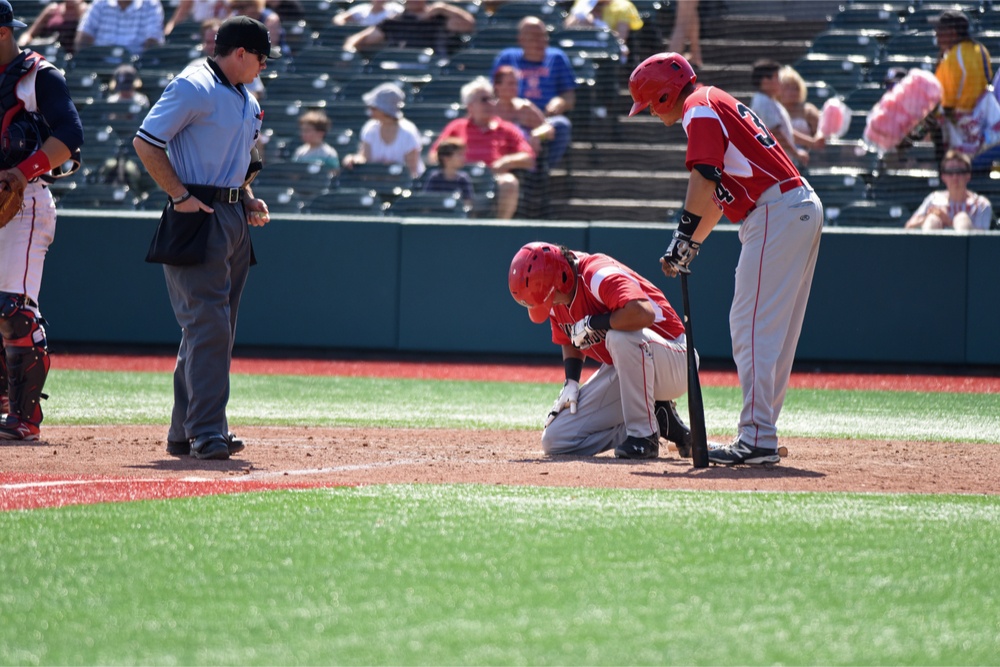While baseball might not seem like a particularly dangerous sport to most — after all, it doesn’t have the hard hits of football or the fast pace of soccer — baseball players do sustain their fair share of injuries, many of which are preventable.
To help you stay safe on the diamond, we’ve broken down seven of the sport’s most common injuries (and how you can avoid them!).
1. ROTATOR CUFF TEARS
The rotator cuff is a set of tendons that attaches the upper arm bone (the humerus) to the socket of the shoulder (the glenoid), stabilizing the joint and providing it with a wide range of motion. Since baseball entails constant overhead motion, rotator cuff tears are a fairly common injury, resulting primarily from improper training, overuse, or sudden trauma. The most common symptoms include moderate to severe pain that worsens when lifting the arm overhead, a deep dull ache in the shoulder, and weakness in the arm. To help prevent rotator cuff tears, be sure to use proper technique (especially when throwing), exercise all of the muscles in your shoulder, and properly warm up before taking to the field.
2. KNEE INJURIES: BOTH ACL AND MCL
Two of the most common knee injuries in baseball are ACL (anterior cruciate ligament) and MCL (medial collateral ligament) tears. The ACL and the MCL are two of the four ligaments in the knee that reinforce the joint and facilitate its range of motion. Tearing either ligament usually results in significant pain and swelling, but ACL tears in particular are often accompanied by a distinctive popping sound. While MCL tears are usually caused by acute trauma, ACL tears in baseball are more likely to be caused by wear and tear over time. Be sure to always properly warm up before training or games, and engage in stretching and strengthening exercises on a regular basis to prevent injuries.
3. MUSCLE SPRAINS AND STRAINS
A sprain is a stretching or rupture of a ligament, while a strain is a tear of a muscle or tendon. Most common in the ankle and knee, sprains are usually a consequence of trauma, resulting in pain, bruising, swelling, and an inability to move the affected joint. Strains share many similar symptoms, but they can be the product of acute injury or chronic damage that accumulates over time. While some strains and sprains may be unavoidable, using proper form, always warming up, and stretching and strengthening can all reduce the risk of sustaining them.
4. SPONDYLOLISTHESIS
Spondylolisthesis is a displacement of a vertebra, usually in the lower back. In most cases, the affected vertebra bulges outward over the vertebra underneath it, impinging or compressing the surrounding nerves in the process. Symptoms of spondylolisthesis often include a sudden pain in the lower back or buttocks that intensifies when bending or twisting, weakness in the legs, and an inability to walk without significant pain. For athletes, the most common cause of spondylolisthesis is sudden trauma, which makes it somewhat difficult to prevent; but maintaining good posture, warming up, and staying in good shape can all strengthen your body against the injury.
5. UCL (ULNAR COLLATERAL LIGAMENT)
UCL (ulnar collateral ligament) injuries occur when the inner ligament of the elbow is damaged, usually due to repetitive stress. Since throwing is so essential to baseball, these injuries can be quite common among players, particularly pitchers. Symptoms of UCL injuries include pain and tenderness on the inside of the elbow, swelling, bruising, elbow stiffness, numbness or tingling in the hand, and a weakness in the arm and hand. UCL tears usually can’t be treated without surgery, but warming up and using proper form when throwing are effective preventative measures
6. SLAP TEARS
A SLAP tear (an acronym for Superior Labral tear from Anterior to Posterior) is a tear or rupture of the labrum, the soft rim of cartilage that lines the socket of the shoulder. Like rotator cuff and UCL tears, it’s quite common in baseball and other sports that demand repetitive overhead motion. It frequently results in pain, weakness, clicking in the shoulder, and a limited range of motion. SLAP tears are often treated through arthroscopic surgery, but strengthening the muscles in the shoulder, regularly stretching and warming up, and using proper form when throwing can effectively protect against this injury.
7. GOLFER’S ELBOW OR THROWER’S ELBOW
Medial epicondylitis, often called golfer’s elbow or thrower’s elbow, is an inflammation of the tendons in the inner elbow, most often caused by overuse. Its symptoms include moderate pain, a burning sensation, and stiffness in the inner elbow, and a sense of weakness or numbness in the forearm. Thrower’s elbow is often treated nonsurgically, but it can be prevented by strengthening the forearm, using proper technique, adequately resting the arm after playing, and always warming up.




